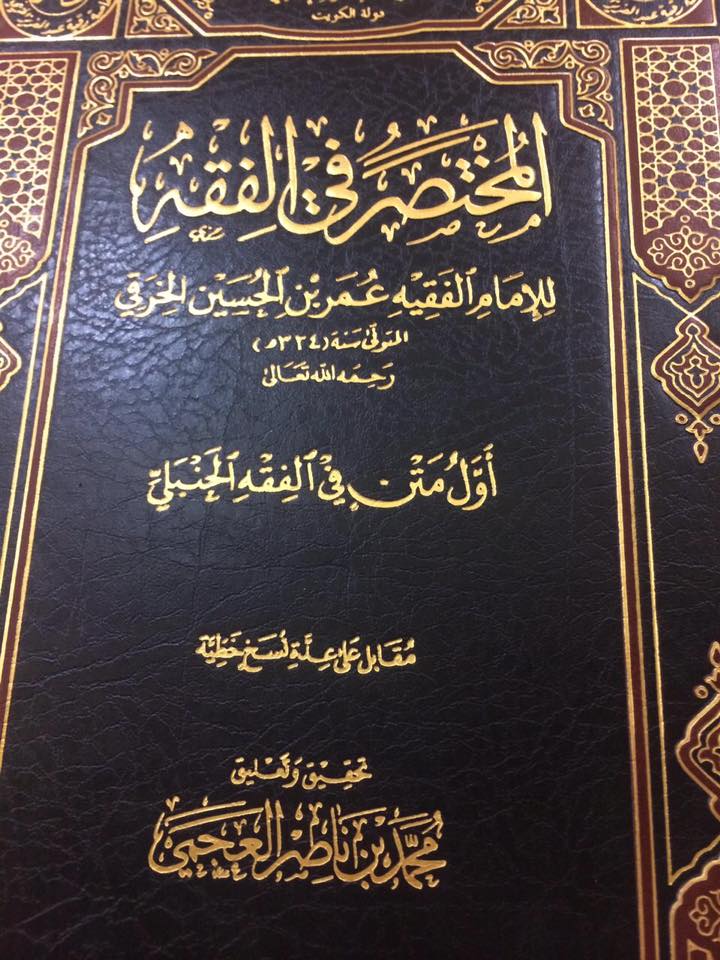Author: Abu-l Qasim al-Khiraqi ‘Umar b. al-Husain al-Baghdadi al-Dimashqi (d. 334 AH)
His name “al-Khiraqi”: They would sell clothes and rags (Khiraq), thus, the name. No one else from the scholars of the Hanabaliah have this ascription besides him and his father (d. 299 AH) who was famously known as “The Successor of al-Marrudhi” as he used to always stick to him. It is not known from which tribe they are from.
It appears that the author wrote this book during the period when the Black Stone was in the possession of the Qaramitah as he says whilst describing the mannerism of Tawaf, “Then the person comes to the Black Stone and touches it if it is present.”; so, him writing “…if it is present” is an indication that he wrote it when the black stone was in the possession of the Qaramitah. They forcefully took the Black Stone during Hajj in the year 317 AH and didn’t return it back to its rightful place until 339 AH.
The author was from Baghdad but after the Rafidah began to rise and the Sahabah were being cursed from the pulpits, he moved to Damascus. Before moving he left his books under someones trust and they were stored away. One day after a fight the place caught fire and all his books were burnt except this book (Mukhtasar al-Khiraqi).
He passed away in Damascus. His death was a result of him always forbidding the evil, due to which he was beaten by the people of Damascus until he died. May Allah have mercy upon him.
He wrote this book after Abu Bakr al-Khallal (d. 311 AH) wrote Jami’ al-Riwayat. In the book he exercises his Ijtihad in choosing the most correct opinion from the different opinions that were narrated from Imam Ahmad (r).
Al-Khiraqi was the first Hanbali to be buried in Damascus and his book is the first legal textbook in the school and unarguably the most famous out of them all. The way he ordered the chapters in this Mukhtasar was the same way al-Muzani (the student of al-Shafi’i) ordered the chapters in his Mukhtasar.
Ibn Badran said in al-Madhkhal:
“None of the books (of this Hanbali Madhab) were served nor given as much attention as this book. Ibn ‘Abd al-Hadi said in al-Durr al-Naqi that his teacher ‘Izz al-Din al-Misri said,
‘(The Mukhtasar of) al-Khiraq has 300 commentaries written on it.’
He also said in al-Maqsad al-Arshad that Abu Ishaq al-Barmaki said, ‘The number of legal issues found in (Mukhtasar) al-Khiraqi is 2300. In short, it is an amazing text; no other legal text gained as much fame as this text amongst the Mutaqaddimin (ancient Hanbali scholars).
Abu Bakr ‘Abd al-‘Aziz, the Ghulam of al-Khallal (d. 363 AH) wrote in his copy of the book, ‘In his Mukhtasar, Al-Khiraqi disagreed with me in 60 legal issues.’ He didn’t mention which ones.
Ibn Abi Ya’la says in al-Tabaqat:
“I looked into the differences between the two (the opinions of Ghulam al-Khallal and al-Khiraqi) and found that it was 98.” He then mentions them briefly.
A lot of work has been done on this book from commentaries and footnotes to rewriting it in a poem and addition more legal issues. Books were also written explaining just the technical terms found within it whilst other books were dedicated in extracting and referencing the Ahadith that were behind these issues.
Scholars who wrote commentaries on the book:
1) The explanation of the author himself. He was the first one to write a legal textbook in the school and the first one to write a commentary on it.
2) Abu Ishaq b. Shaqla (d. 369 AH)
3) Abu Hafs al-‘Ukbari (d. 387 AH)
4) Al-Hasan b. Hamid (d. 403 AH)
5) Ibn Abi Musa (d. 428 AH)
6) Al-Qadi Abu Ya’la (d. 458 AH) (some parts have been published)
7) Abu ‘Ali b. al-Banna’ (d. 471 AH) (published)
8) Ibn Zaghuni (d. 527 AH)
9) Abu Hazim Muhamad b. Abi Ya’la (d. 527 AH)
10) Muwaffaq al-Din Ibn Qudamah (d. 620 AH) in al-Mughni. This is the most famous commentary on Mukhtasar al-Khiraqi (published)
11) Ibn Abi-l Hija (d. 661 AH) in hsi work al-Muntasar Sharh al-Mukhtasar
12) ‘Abdullah al-Harbi (d. 681 AH) in his work al-Muhimm.
13) Abu Talib Abd al-Rahman b. ‘Umar al-Darir (d. 684 AH). He has two commentaries on it known as al-Kafi and al-Wadih.
14) Al-Tufi (d. 716 AH). His commentary is on half the book.
15) Al-Hibal (d. 749 AH). His commentary is extremely brief.
16) Al-Zarkashi (d. 772 AH) (published). He has a second commentary which he summarised from his first commentary but he didn’t complete it.
17) Qadi-l Aqalim ‘Abd al-‘Aziz b. Abi al-‘Izz al-Maqdisi (d. 846 AH)
18) Ibn al-Mibrad Ahmad b. Hasan b. Ahmad b. ‘Abd al-Hadi (d. 895 AH). Most of it is complete.
19) Al-Asfahani
20) Ja’far al-Siraj (d. 500 AH). This commentary was written as a poem.
21) Ahmad b. al-Husain al-‘Iraqi (d. 588 AH). Also a poem but only explains the Fiqh of Worship.
From those who rendered Mukhtasar al-Khiraqi into a poem:
1) Makki b. Hubairah al-Baghdadi (d. 567 AH)
2) Hasan al-Sunnah Abu Zakariya Yahya b. Yusuf al-Sarsari (d. 656 AH) called “al-Durrah al-Yatimah wa-l Mahajjatu-l Mustaqimah” (published). It is a poem that ends on the letter “Dal”. It has 2775 couplets and is published.
It was explained by Muhammad b. Ayyub al-Tadhiqi al-Hanafi. This is extremely strange as he is a Hanafi explaining a Hanbali legal text written in poetry.
Ibn Badran has an explanation on the The Chapter of Inheritance from the poem in his Kifayatu-l Murtaqi Ila Fara-id al-Khiraqi which is also published.
3) Shams al-Din Muhammad al-Musili (d. 656 AH); only the Fiqh of Worship.
From those who further abridged Mukhtasar al-Khiraqi:
1) ‘Izz al-Din Ahmad b. Ibrahim b. Nasri-llah al-Baghdadi (d. 876 AH)
From those who added more legal issues onto the text:
1) al-Muwaffaq Ibn Qudamah in his al-Hadi which is also known as Umdatu-l Hazim Fi-l Masail al-Zawa-id ‘An Mukhtasar Abi-l Qasim” (published)
2) Abu Zakariya, called Wasitatu-l ‘Aqd al-Thamin Wa ‘Umdatu-l Hafidh al-Amin” which is poem of 2000 couplets.
3) Abu Bakr al-Jira’i (d. 883 AH) called Ghayatu-l Matlab Fi Ma’rifati-l Madhhab (published). He also relied on al-Furu’ of Ibn Muflih.
From those who explained the rare words found within Mukhtasar al-Khiraqi:
1) Abu-l Mahasain Muhammad b. ‘Abd al-Baqi al-Majma’i al-Musili (d. 571 AH)
2) Abu-l Mahasin Yusuf b. ‘Abd al-Hadi, who is famously known as al-Mibrad (d. 909 AH) called al-Durr al-Naqi (published)
He also has a book in which he extracts and references all the ahadith linked to text called Al-Thaghr al-Basim Fi Takhrij Ahadith Mukhtasar Abi-l Qasim.”
 8237total visits,8visits today
8237total visits,8visits today

